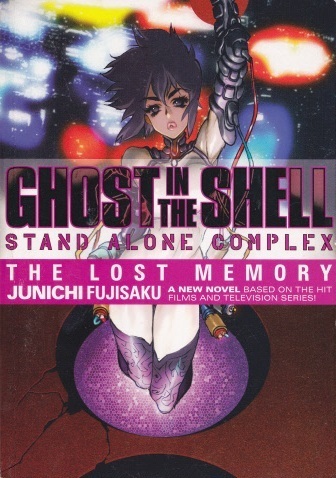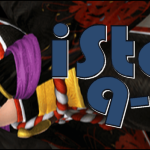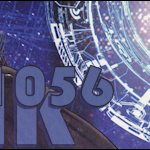Kayarath’s Adventures in Lost Memories

No matter how much we advance technologically, the tools of the past still have their uses. A laptop wouldn’t be nearly as versatile as a cyberbrain, but it’s much better for keeping secrets since a laptop is expendable while a cyberbrain wouldn’t be. Even people with the tools to create video games and anime would still want to use novels to tell their stories, like Junicihi Fujisaku did with Ghost in the Shell.
For those who don’t know and don’t want to check wikipedia, Ghost in the Shell is a cyberpunk themed science-fiction manga. It takes place in Japan’s near future, where the internet is bigger, the technology is better, and everybody is at least part machine. The story’s protagonists are Section 9, an elite security unit of the Japanese government specializing in information technology. They grapple with crime, corruption, war, and what it means to be human in a world powered by machines. Like many successful manga, it spawned movies, anime, various merchandise, and even a few novels.
Junicihi Fujisaku is a game director and writer for Production I.G. and one of the first graduates from its “Oshii Academy,” an in house training think-tank. He wrote the screenplays for Appleseed XIII, Blood-C, and many Ghost in the Shell: Stand Alone Complex episodes. Junicihi Fujisaku also wrote the Ghost in the Shells novels that I’m reviewing here today.
Now that the required exposition is out of the way, let’s talk books. If your goal is to dive deeper into Ghost in the Shell, then your search is complete. There’s a good deal of exposition on locations, how they operate, cultures, past events, and how the members of Section 9 go about their business. You get a better understanding of places beyond “some location where the Major shoots a bunch of bad guys.” If you want to learn more about how the Ghost in the Shell universe operates, there are plenty of bits of information and lore to process. If your interests are more focused on a certain elite crime fighting unit, then you’re also good. It’s just plain enjoyable when the members of Section 9 banter with each other. You’ll also get better insight on how the characters think and feel since the books take the time to describe the why of their actions as much as the how. However, like the anime, the focus tends to be on mostly the Major, with splashes of Batou, Togusa, Saito, Aramaki, various one shot side characters, and the always adorable Tachikomas. The other members of Section 9 play minor roles. If they’re gonna get their turns in the spot light, it won’t be in these books.
You won’t need to be a Ghost in the Shell junkie to understand these novels though. Each book is its own stand alone episode that doesn’t require knowing a large backstory. As long as you know the basic ideas of Ghost in the Shell, you’ll get along well enough. However, I think these book are more for existing Ghost in the Shell fans. For fans, it’s viewing something you already like through a different lens, which is always interesting to me. I have no idea if a non-fan would like these books and I’m not willing to guess on that since I’m no book critic. These perspectives are from a person who watched all of the Ghost in the Shell TV series and liked them immensely.

Available online or even in real life!
“The Lost Memory” was the first novel published in 2006 for U.S. audiences. It starts off with Section 9 investigating a series of seemingly random terrorist attacks from teenagers. Not long after, they follow the trail of clues to a military school and it switches perspectives to Kazei, one of the school’s students. I found it quite refreshing to shift the perspective to someone outside of Section 9. It’s also a nice change of pace to have some obvious foreshadowing going on here. Being able to think, “Hey, I can predict that this character will be important as well as the cause of the plot’s problem” while enjoying Ghost in the Shell is a rare treat.
The middle of the book gets dragged down in some random investigations and then switches over to a completely different problem. Now Motoko and friends are charged with protecting a VIP with more people after his head then Vash the Stampede. It’s a difficult but doable job for our favorite crime fighting cyborgs, but a ridiculous sudden plot twist somehow manages to wreck everything at the last moment. And wouldn’t you know it; somehow it involves Kazei! While there are some justifications to it, I felt that Fujisaku was just trying to throw the biggest curve ball he could manage. It just feels too sudden and forced for me.
Overall, it less of an over reaching plot and more of a bunch of cool random things that happened that then try to form a plot together but don’t quite make it. There are nice touches like when the story comment on how professional Togusa is because he’ll shield someone with his body even though he’s not a cyborg at all; or when a two second hacking is described using several paragraphs to emphasize how quickly you can accomplish complex tasks in the net. It’s also neat to learn things like how difficult life is for non cyberized people, and how jarring it would be to suddenly have a computer in your brain. A high point in the book is the Major taking a trip to a “Dreamery” to question its owner. FYI, a Dreamery is a place where people can download enjoyable experiences into their cyberbrains to experience like dreams. The Dreamery owner is quite a character with at least three escape plans, and enough extra bodies (I mean that in the literal sense, as in he has at least three bodies he controls with his mind) to go along with them. They’re all nice things, but they don’t form well together. A bunch of great snacks does not make a meal. You would read this to learn more about the Ghost in the Shell universe more so then for the story.

This has Tachikomas in it! You can’t resist!
Revenge of the Cold Machines is a must read for any Ghost in the Shell fan. Simply put: there’s a Tachikoma story in it! That’s all I need to say. That should be more then enough to open up your wallets! Seriously, stop reading this, go buy the book, jump straight to page 71, and get ready to have your heart melt. If by some chance you decide to start at the beginning, you’ll find a short but sweet story involving someone trying to assassinate Chief Aramaki. It doesn’t try to confuse you with a sprawling plot. It’s all about setting up and resolving dramatic conflict with violence and the required surprised twist. I was very surprised by it, but in a “I totally was surprised by this” instead of a “this doesn’t make sense” kind of a way. If you decide to read the story after the Tachikoma one, you’ll figure out that the assassination plot and the Tachikoma tale were setting up for a dramatic finale. The finer details are lost on me, but I do understand wanting revenge and using the latest military cyber-bodies to achieve it. Even if I don’t know why, I can enjoy cool fight scenes.
The second novel is much better story wise. It’s a trilogy of smaller, independent stories. Each one of them is more focused on telling a single plot, not getting distracted by random things. All three parts can stand up on their own merits. The last episode of the book, Revenge of the Cold Machines (sounds familiar) has good character moments like seeing Togusa applying his old fashion detective skills in dealing with people. You also get to see a rare team up with Batou and Saito. While they do work well together, it’s interesting that they do call each other by the their titles of “ranger” and “sniper” a few times. How much is it a sign of them joking with other during extreme danger and how much is it a reflection of them being only work associates? I don’t know. Even if those characters moments weren’t there; even if the other two stories were pure garbage, I would still say buy this book! The Tachikoma story is that good!

Sadly, these books are not a sign of a third season for the Ghost in the Shell television series.
The third, and final novel, is entitled White Maze and has the Major battling… VAMPIRES!!!! No, it’s not something as scary as that. The threat is actually a virus capable of completely reprogramming a person’s emotions. Wait, isn’t that much more scary then vampires once you think about it? Ether way, it’s up to Section 9 to stop it. Well, it’s more like it’s up to the Major to stop it since this book largely follows her perspective. The first part of the book is the set up phase. Here we learn the situation, get some history, do some investigation, etc. It’s overall a pleasant read with a few interesting moments. The funniest scene of the book (and all three of these in general) is the Tachikomas discussing Batou’s relationship with the Major. I just find it hilarious that advanced A.I. would play the role of a peanut gallery like it’s a romantic comedy. A more serious note is the Major gaining a professional interest in the virus’s creator. If you get Motoko Kusanagi interested in you, chances are you done something really good or really bad.
The second half has the Major trying to find the virus’s creator; by going undercover. Alone. With no extra equipment what so ever in an area describable as “post-apocalyptic.” If you haven’t figured it out yet; Motoko Kusanagi is a character who takes risk as large as gunmen, yet survives them due to her Mary-Sue levels of power. The Major can do in minutes what takes a team of specialists several days. This is no exaggeration. She does such a task during the story. Later on, she picks up some random gang members to arrest the virus creator while he’s guarded by a large terrorist group. Of course it’s not as simple as that. There was another elite crime fighting competing with her over the guy and they brought along a police force to help them out. Also, the Major was functionally blind while all this was happening! I never realized how impossible it all was until I wrote this!
This whole story isn’t just about the Major doing incredible things. The story of the emotion changing virus and it’s creator is a touching tragedy (that I won’t spoil for you) with revenge, wrong doing, and all that good drama stuff. An unlikely third star of White Maze is the city of Tokyo. During the third World War (or something) it got mysteriously destroyed. Now in ruins, it has become a largely lawless area where gangs, refugees, and residents of Tokyo too stubborn to leave survive the best they can without much social structure. A person can get ganked just by walking down the wrong street at the wrong time. It’s basically a ghetto in many respects. Yet it’s also more alive as well. There’s a strong sense of community there. You get the feeling that the people there are more engaged with life instead of merely passing through it. By reading the book, you can understand the soul of the place.
White Maze finally succeeds in telling an entire engaging tale in novel form. The Lost Memory does have it’s moments but they didn’t mesh as well as they could have. Revenge of the Cold Machines was basically three shorter stories put together. They were all fun and great, but they were more stand alone episodes then anything else. White Maze is the most novel like of them all. You got to walk a mile in Motoko Kusanagi’s shoes and that is a journey many people would want to take.
Hopefully I gave you enough data to be able to figure if you want to read these yourself. They’re all available on the Dark Horse Press website if you want to order them online. Of course, I can’t decide for you to love or hate these books. All I can really do is try to transfer my memories of them to you so you better act on your own desires. Let me remind you, however, that Revenge of the Cold Machines has a Tachikoma story in it. Tachikomas! How can anyone resist the Tachikomas?















Good read Kay, kudos to the Trigun reference! I’m definitely checking out White Maze! And yes, any Tachikoma storyline makes it worth checking out! 😀
One of the great series, I love everything GitS.
GitS is a must seen series and reading your article makes me wanna go and watch the series again